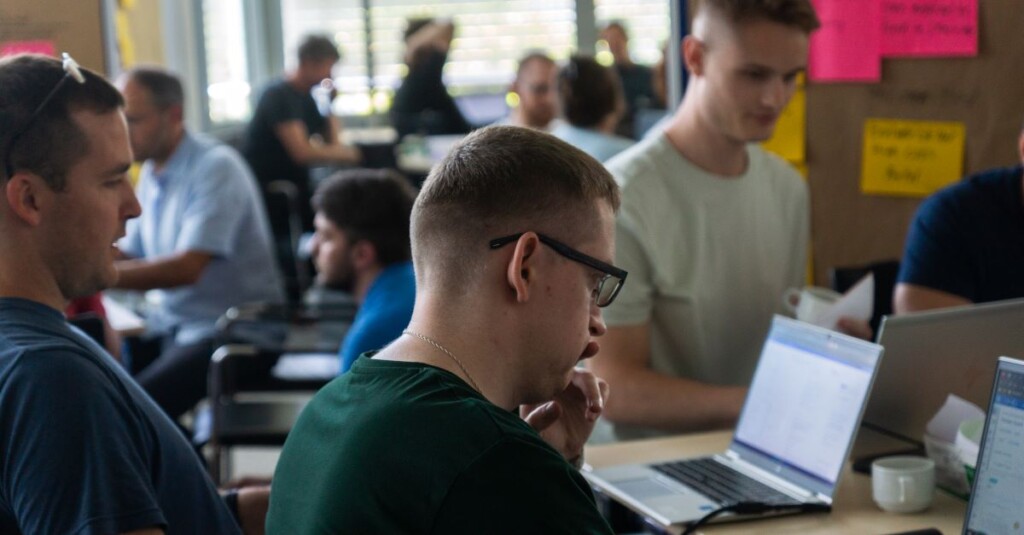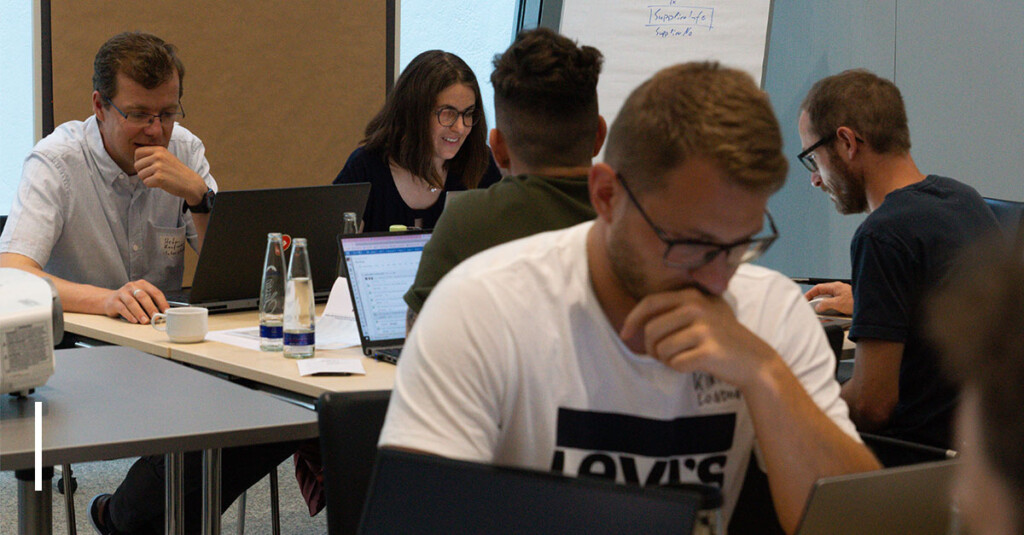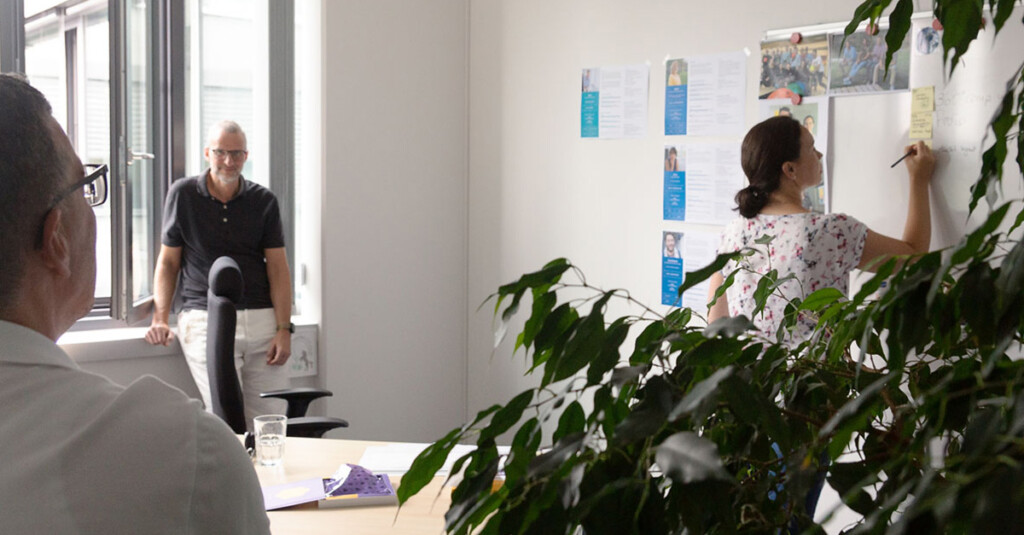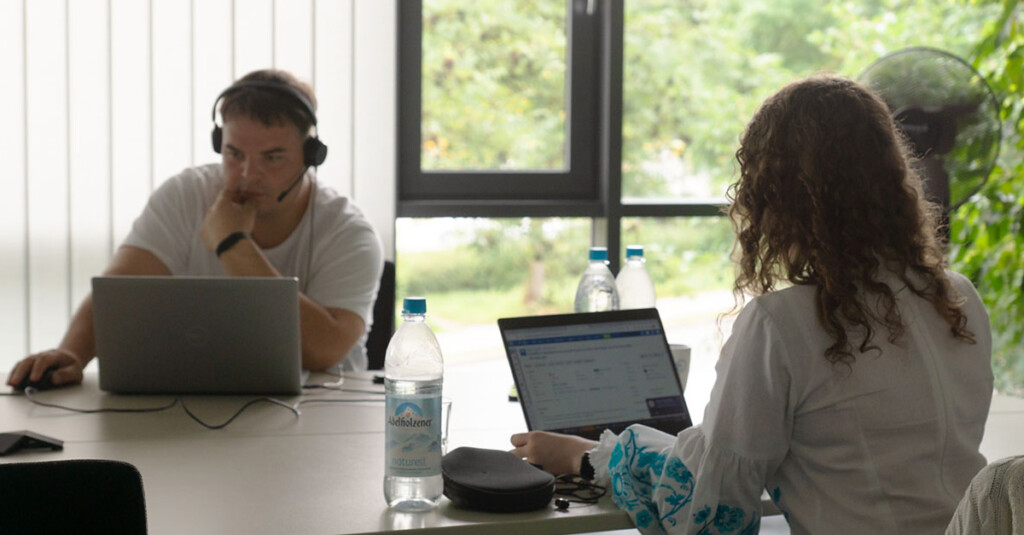Skip to content
May we introduce you to our new functions? These show not only our commitment to continuous innovation, but also concrete progress in various areas of our product portfolio: Visibility & AnalyticsTo enhance customer interaction in our Corporate Carbon Footprint survey tool, we have integrated a chatbot. This chatbot can respond precisely to user inquiries and assist with survey completion in various languages. Further to this first concrete use case, the chatbot acts as a pilot project for the integration of generative AI into our product portfolio. Source-to-ContractNew features in Cost Breakdown Structure (CBS) within SupplyOn Sourcing enable even more flexible and efficient workflows. Users can now easily toggle specific sections on or off to access only relevant information. Additionally, they can specify cost components required for each part number, streamlining supplier responses and saving time. Supplier Quality ManagementThe solution Technical Review has enhanced valuable functions to increase efficiency and flexibility.One of these functions is the "bundling" function, now accessible via a customer system. This allows customers and suppliers to deal with similar materials with one Technical Review object, thus avoiding many duplicate entries.Moreover, two new columns will soon be integrated into the inbox table, displaying details such as the last modification and the person responsible for it.Another improvement involves the creation of new objects by customer users. It becomes easier to add necessary content immediately before activation, as the object is saved in "Create" status and only requires defined fields to be filled prior to activation. We look forward to introducing you to more exciting developments in the coming months. Stay tuned to see what innovations you can discover next time.

What was your career like before you joined SupplyOn?Israel: I have been working as a Full Stack Software Developer for 5 years and have been with SupplyOn since 2023. I studied industrial engineering. During my studies, I already gained experience in software development through part-time jobs, internships and working student activities. I work remotely from Berlin.Fangfang: Before I started as a full stack software developer, I worked as a UI/UX designer in the IT industry for 8 years. For example, I managed websites in-house for various companies.There I already worked closely with full stack developers and discovered my interest in coding, but had no opportunity to gain professional experience in programming.Through the Full Stack Developer Java Bootcamp at neue fische GmbH, I managed to make a career entry at SupplyOn. How did you become interested in SupplyOn?Fangfang: The Java and React focus of my current project fits perfectly with the knowledge I acquired in the bootcamp. The frameworks are applied in a modern way at SupplyOn, which appealed to me.I also live near Hallbergmoos near Munich, so SupplyOn is also ideal for me in terms of location, as I personally like going to the office.Israel: I was looking for a new professional challenge as a full stack developer and heard about SupplyOn through a recruitment agency.In addition to the industry and working environment, what was exciting for me was that I could continue to apply my previous knowledge of the .NET framework, but also learn a lot of new things in my role.The possibility of flexible working hours and remote working from Berlin were also reasons for me to choose SupplyOn. What does a typical working day as a Full Stack Developer at SupplyOn look like?Israel:I usually start at around 8am and start coding. At 10 o'clock we have our stand-up. This is when we briefly discuss the current status with the rest of the team. We clarify who would like to go into more detail with whom in the team. After the stand-up, individual follow-up appointments are then arranged. The daily routine is then divided into meeting-free time, during which I program, and coordination meetings with team colleagues and the product owner.Fangfang:As we work with Scrum and therefore in sprints, there are also monthly meetings. At the end of each sprint, usually every other week on Fridays, we have a review meeting. This is where we present our results from the last two weeks to the Product Owner. This is followed by the retrospective. At this meeting, the Scrum Master, we as Full Stack Developers and our Product Owner come together and discuss how we can improve our collaboration. On the following Monday, we then start planning the next sprint. What all SupplyOn departments have in common is that all Scrum teams meet quarterly in line with SAFe (Scaled Agile Framework) to discuss dependencies and risks and agree on the overall sprint planning for the next three months.Find out more about the role of Full Stack Software Developer at SupplyOn in Hallbergmoos near Munich on our Full Stack Developer careers page. How is the balance between front-end and back-end development handled in your position?Israel: When a user story or feature is implemented, it is the exception rather than the rule if only front-end or only back-end development is involved. Accordingly, I develop in both the front-end and back-end areas.At the beginning of the two-week cycle, during sprint planning, we decide which user stories are to be implemented.The tasks are clustered into sub-tasks. Sometimes we divide the front-end and back-end development between us, depending on the strengths and preferences of the team members. But we also implement both.Fangfang: For me, as a career changer coming from UI/UX, I am currently focusing on deepening my front-end knowledge.I would estimate that I do 70% front-end development and 30% back-end development. With my direct team colleague, it's the other way around.As full-stack software developers at SupplyOn, we have the opportunity to independently determine the proportion of programming we do. A 50%/50% split is not compulsory. What projects and challenges are you currently working on and which technologies and tools are you using specifically in the technology stack?Israel: In my team, we are currently working on a traceability application. This helps our customers to trace products down to the raw material level in order to solve quality problems quickly and continuously improve product quality.In the back-end, we write the software solution in the .NET Core Framework, ultimately developing a REST API that is then used by the front-end or other services. We use React for front-end development. We are free to choose the development environment. I prefer Visual Studio and Visual Studio Code. Colleagues of mine work with JetBrains Rider, for example. Our applications then run on Azure Web Services.We carry out several customer projects simultaneously in the area of traceability. The application was developed a few years ago for a first customer and was expanded this year to include various use cases and multi-client capability.The aim now is to make the application as usable as possible for all customers and to support customers already working with the product in integrating the new features into their tool landscape.At the same time, a new product, the Product Carbon Footprint application, was developed. The challenge here was to certify it and ensure compatibility with the CatenaX industry network.Fangfang: My team is developing a Capacity Management solution for customers in the automotive and aerospace sectors. The application supports our customers in increasing the resilience of their supply chain through smart capacity management of suppliers.We use Spring Boot, Gradle and Docker as frameworks for back-end development. We program with IntelliJ as our development environment. Our databases are also based on Microsoft Azure Web Services. We also code the front end with React. We develop the software solution on a customized basis according to our customers' requirements.In our case, the customers have specific ideas about implementation and compatibility, so our challenge is to create the application end-to-end in a target-oriented and functional way.What I really like about SupplyOn is the professionalism of our Product Owner when it comes to working with Scrum: it is a real practice that we can only concentrate on software development and our sprint phases and the Product Owner cushions any issues that go beyond this.What does the code review and quality assurance process look like?Fangfang: There is a code review for every task. After pushing my code, my team colleagues read it and approve it before merging and branching can take place in the main branch. We have a high test quota, which must be met as a minimum. We write a test for almost every method.Israel: It's similar for us. We use Git for version management. We use Azure DevOps to host our Git repositories. New or changed code is always developed in a separate branch first, then we create pull requests.After running automatic pipelines, teammates check the code. This is done at least according to the four-eyes principle. We then usually run several feedback loops.After the (also automated) installation in the QA environment, further manual tests can be carried out. At the same time, the product owner can also test the new developments here and provide feedback on whether the requirements have been implemented as expected. How do you use the opportunities for professional development and training?Fangfang: Every two weeks on Thursday afternoons, we have a cross-team tech meeting and receive training from internal and external development teams on innovations, such as library updates or similar.Individual training requests can also be discussed with our manager. I am attending a React conference this year to keep up to date with trends in this framework and to get inspiration for my own work from keynote speeches.There are also standard training courses that we go through as Full Stack Software Developers at SupplyOn, such as SAFe training.Israel: I also find the exchange with colleagues for internal training very valuable. Most recently, I wanted to learn more about automated testing in front-end development and used learning platforms to do so.Self-organized learning and access to learning platforms are supported by SupplyOn. Our Scrum Master colleague Angila, for example, used it to deepen her knowledge of Docker and Kubernetes and tells you more about it in her experience report on Agile Learning. What is the corporate culture and working environment like in the team?Israel: Very friendly, personal but also very professional. The team members are always open to feedback and I find the collaboration very constructive. There is very good interaction with colleagues across all hierarchical levels.Fangfang: My team is very international. There are colleagues from China - like me -, India, Turkey, France, Ukraine and Germany. Everyone helps each other. I really like that. What flexibility do you have in terms of working hours and location?Israel: The flexibility of working hours and location was one of the main reasons why I chose SupplyOn. The working day is not overloaded with meetings and the meeting-free time is completely flexible and can be arranged individually.I can work from anywhere in Germany and several weeks a year from other European countries. I have already used mobile working abroad this year and would like to make even more use of it in the future. Why would you recommend SupplyOn as an employer to Full Stack Software Developers?Israel: SupplyOn is an established company, but also a company with a lot of potential that is still in the process of developing and where there are also many opportunities to help shape software development. SupplyOn is a very forward-looking company that attaches great importance to ensuring that we as employees continue to develop. This is also very important to me personally and is practiced here.Fangfang: Due to its size, there are still very flat hierarchies and there is comparatively little bureaucracy. In particular, lateral entrants or Software Developers with a previous focus on front-end or back-end development are given individual on-the-job training opportunities and can grow with their tasks. Like Fangfang and Israel, would you like to use your Full Stack Developer skills to help shape the collaboration of global supply chains in a sustainable way?Apply now for our Full Stack Developer position:Senior Full Stack Software Developer (w/m/d)

May we present the new features that our developers have realized over the past months. These are the highlights from the different areas: Visibility & AnalyticsOur goal? Continuously increasing transparency for transports! In the Container Tracking Overview customers can now view the current position of the ships with their shipments on a map. The color scale shows whether the shipments arrive on time (green) or whether there are deviations (yellow or red depending on the length of the delay). Supply Chain CollaborationThere are many new functions to discover in Supply Chain Collaboration:In the order overview, a preview now shows orders in PDF format and allows to navigate through the list at the same time.Previously, collaboration within the solution could only happen between the customer and their suppliers. With "Extended Collaboration", the customer can now define an additional party (for example a logistics service provider) that performs certain tasks for one or more suppliers.The overview of call-offs (call-off preview, delivery call-offs, detailed call-offs) now also appears in a new and modern user interface.In the Capacity Management solution, our development teams have added an assessment-driven component. The customer can use it to carry out a structured evaluation of the supplier's capacity data. This is particularly helpfulin case of poor quality,in the start-up phase and for new developments,for strategically important parts,for new suppliers - or simply to reduce the general risk in the supply chain. Supplier Quality ManagementThe compact "All Questions" overview allows users to view all questions in the Technical Review solution and analyze their status at a glance. If required, users can also access a specific question directly from here. This function is very useful for both customers and suppliers, especially for complex questionnaires.In the Problem Solver solution, it is now possible to work with a database when manually entering material master data. This is particularly interesting for customers who do not use their own backend system. AirSupplyWithin AirSupply the Practical Problem Solver (9S) has also seen some changes:The new analysis solution with KPIs can be used to monitor the performance and number of 9S documents created over time.The "Quality Wall" is now also available as an additional tool for improving quality. The customer can activate it on a 9S document to carry out additional important checks.The customer can now also record identified quality defects - so-called non-qualities - and share them with the supplier.With the advanced search, users can create and save their repeated searches as individual profiles. So many new functions! Stay tuned and discover the results of the current development phase!

Time flies! Twelve weeks have gone by again: We present the work of our development teams in the solutions Supplier Quality Management, Invoicing and AirSupply. Supplier Quality ManagementThe goal of the last three months was to create more transparency for the customer and supplier in the Technical Review solution by means of a new status display in the navigation area: As a result, the users can now easily identify the categories in which questions have already been answered. They can also immediately check which categories contain questions that have been accepted, not accepted, or tentatively confirmed. InvoicingThe user interface of SupplyOn Invoicing has been rebuilt from the ground up — both in terms of design and functionality: Users can now see a lot faster which functions are available to them and how they can use them.Thanks to the revision of the invoice validation, it is now possible to identify and correct potential validation errors more easily.All lists, such as the invoice list, now have a full table view with extended display options. For example, the users can more easily show and hide columns, sort, move or filter them as needed.Even non-registered suppliers can now view the processing status of invoices in the Payment Status Overview. They no longer have to contact the customer's support team and get the information they need much faster.Find more information about the new user interface here. AirSupplyThe last few months have also been dedicated to making it even easier for small and medium-sized enterprises (SMEs) to use the AirSupply SCM solution. The Easy Starter Package includes process simplifications as well as a streamlined message format that can be implemented even without any mapping experience. The new preconfigured software enables a stable and encrypted exchange oforder data,order confirmation dataand forecast data. In the Scaled Agile Framework, one development period seamlessly follows the next. So stay tuned to find out which new features we will develop in the next Program Increment.

Our development teams have been working at full power over the past three months. Check out the results in the areas of Visibility & Analytics, Supply Chain Collaboration, Invoicing and AirSupply: Visibility & AnalyticsAt the end of the latest development phase, we are introducing new options in the Product Footprint solution: From now on, it includes a comment function that facilitates the collaboration on the platform. Added to this is the new "Create parts" function. This allows the user to easily create the parts that are not existing in the list of parts. Supply Chain CollaborationFresh breeze also in the area of Supply Chain Collaboration. New, modern user interfaces now offer even faster orientation in the following overviews:Orders and Line Items Overview (new: streamlined way to confirm orders)KanbanGoods ReceiptDue DeliveriesFor shipping notifications, there is now the possibility to prevent early creation of ASNs, as well as to reduce the manual effort required to maintain the smallest packing unit.The new "Issue Center" functionality shows where a user needs to take action to ensure a smooth business process. In the first step, inconsistencies in the delivery forecast process are provided. InvoicingIn many Chinese regions, an additional option for creating Fapiaos (domestic Chinese invoices) using the Golden Tax System has now been established. The so-called "Fully Digitalized e-Fapiao" is currently in pilot phase. Suppliers located in these regions might be obliged to use Fully Digitalized e-Fapiao instead of traditional paperbound Fapiao.Invoicing now supports the necessary download format in addition to the known transfer options. All other steps in the Golden Tax workflow remain unchanged. AirSupplyThe new Repair Order process in AirSupply allows customers to place repair orders for suppliers. This new process is based on the existing order process, but supports some specifics of repair processing:The customer can inform the supplier of the date of dispatch and the expected date of arrival.The supplier or repair center confirms receipt of the parts and, after evaluation, can upload a cost estimate in AirSupply, which is immediately sent to the customer.The supplier specifies the expected repair duration and costs. This allows the customer to schedule and agree on the date and price with the supplier - all steps can be carried out seamlessly in AirSupply. Did you like the features presented? Stay tuned to find out what enhancements our development teams will introduce in the coming months.

We kick off the new year with a look at the achievements of the past development phase (Program Increment 2022-04). Here you will find an overview of the most important innovations in the SupplyOn solutions: Visibility & AnalyticsThe development teams have done a great job in the area of Visibility & Analytics in designing the new solution "Product Footprint".The introduction of the Act on Corporate Due Diligence Obligations in Supply Chains shows that it is becoming more and more important to determine and prove the ecological footprint of the own products. We have implemented two sections in the new solution for this purpose:The "Actual Footprint" determines the footprint of all parts that are already produced in series. It is possible to request the required certificates from the supplier.If a component is still being developed or has not yet been ordered, meaning there is no part number for it yet, the "Planned Footprint" function determines a rough indicator of its future CO2 impact through production and transport.Besides the implementation of this new solution, there is another innovation: the Flexible Survey solution has been integrated into Strategic Risk Management. Such linking of the solutions creates a seamless user experience.From now on, there are three possible ways to select suppliers for the survey:draw a "Circular Area" on the map and select all suppliers in the marked zoneuse the "Polygonal Area" to draw a polygonal area and thus define the suppliers to be addressed even more preciselyselect suppliers regardless of their location using various filter criteriaThe email addresses of the recipients of the survey are drawn from the Business Directory and thus do not have to be entered manually. Supply Chain CollaborationIn Supply Chain Collaboration, we start off 2023 with three new features:From now on, individual supplies can be tracked at the level of purchase order delivery schedules across all processes — from demand to goods receipt booking. This also simplifies the connection to customers with Oracle ERP systems.When creating transport and advance shipping notifications for the loading address, the supplier can now create an address book and this way increase data quality.If a supplier user only works with selected customers via SupplyOn, he can now individually adapt and restrict the e-mail notifications to the customers he is responsible for. Supplier Quality ManagementIn the Technical Review solution, the user now has more options for selecting the system status and for displaying longer texts. In addition, a comment function has been added to the measures overview. This makes it even easier for the customer and supplier to exchange information on a measure level.When managing objects in SupplyOn Project Management, the selection of objects to be revised has been considerably simplified for administrators: the additional upload function speeds up the process significantly. InvoicingThere are also some new enhancements in the area of invoicing. To better support the individual workflows of suppliers, it is now possible to manually close billable items (without generating invoices within SupplyOn). This allows suppliers to close items that have been invoiced outside the platform and to keep their list views up to date or adjust them at a later date.The second innovation is designed for Mexican suppliers, as they must have domestic invoices and credit notes approved by a state authority (Servicio de Administración Tributaria "SAT") before they can be forwarded to the customer (so-called "clearance procedure"). Invoicing will also support this process in Mexico in the future and thus optimally accompanies the prescribed workflow. AirSupplyIn the last Program Increment, a helpful feature was implemented in 9S Practical Problem Solver (PPS): Within the PPS document, the supplier can now assign the added problems to the root cause entries under "Step 4 - Identify root cause(s)".The customer has the advantage that he can see at a glance which problems contribute to the root causes. He thus helps his supplier to process the PPS document quickly. So many innovations! Stay tuned for the next update on SupplyOn's new features that will be available in three months.


